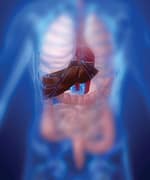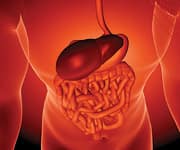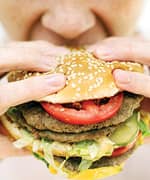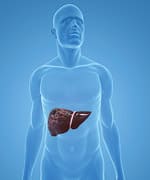Life Extension Magazine®
Little known to the general public is the silent epidemic of non-alcoholic fatty liver disease or NAFLD, which afflicts up to 40% of all Americans.1 NAFLD particularly targets those who carry around excess weight. For the nearly 70% of Americans who are overweight or obese,2 that figure rises to a shocking 50-100%.3,4 Ominously, NAFLD sets the stage for a progression of lethal diseases that can include cancer, atherosclerosis, and diabetes.5,6 Risk of death from all causes skyrockets more than four-fold in NAFLD sufferers - and more than eight-fold for early cardiac death.7 Because of both physician and patient ignorance, most victims of NAFLD are entirely unaware they have it. No drug can halt this widespread disease's potentially lethal progress.3 The exciting news is scientists have recently identified a novel intervention to halt two of NAFLD's core pathologic processes - lipid peroxidation, wherein excess liver fat turns rancid under continuous assault from free radicals, and rampant oxidative damage from disease-induced mitochondrial dysfunction. In this article, you will discover how a beneficial adaptogen called Schisandra chinensis and a patented proprietary extract of the melon Cucumis melo work in synergy to restore vital antioxidant functions typically depleted in NAFLD patients. Rancid Fat and Mitochondrial DecayNAFLD (non-alcoholic fatty liver disease) has been called a disease of modern living. It is a direct consequence of the typical American sedentary lifestyle and a diet rich in sugar and saturated fats.8 Inactivity, overconsumption, and emotional stress result in a spiral that starts with overweight and obesity and culminates in metabolic syndrome, a cluster of deadly fat- and sugar-related physiological and metabolic derangements that range from hypertension to type 2 diabetes. NAFLD is now widely recognized as the liver's manifestation of metabolic syndrome.8 It begins with accumulation of excessive amounts of liver fat in the form of triglycerides.9 Fat is highly vulnerable to oxidative damage, and massive oxidative stress is the next step in development of NAFLD, in the process known as lipid peroxidation.8,10 Restoring Youthful Liver Defense Mechanisms
When we are young, we're protected against this deadly cascade of events by two complementary mechanisms. In the first, a liver enzyme called superoxide dismutase, or SOD, converts highly reactive free oxygen radicals into hydrogen peroxide.11 That delays but doesn't end the threat of lipid peroxidation, because hydrogen peroxide itself generates new free radicals of its own. To fully quench the free radical threat, a second set of antioxidant enzymes is recruited: catalase and glutathione peroxidase, which act on hydrogen peroxide and quickly convert it into harmless water molecules.12,13 The extraordinary oxidative stress inflicted on the liver in NAFLD, however, puts all of these protective enzyme systems into overdrive. Early in the disease, their activity is ramped up substantially in an effort to compensate - but eventually they become depleted and burn out.14-17 As the body loses its natural primary antioxidant mechanisms, it accumulates lipid peroxidation products, and liver mitochondria begin to fail. This makes people increasingly vulnerable to non-alcoholic steatohepatitis, cirrhosis, fibrosis, liver cancer, and cardiovascular diseases.10,18 Supporting the liver's mitochondrial antioxidant enzyme systems is a vital step in preventing the consequences of NAFLD. As you will now see, the synergistic action of Schisandra chinensis and Cucumis melo directly replenish essential SOD, while at the same time stimulating glutathione peroxidase, effectively targeting lipid peroxidation and mitochondrial dysfunction in the liver. Optimizing Liver Mitochondrial Function and Antioxidant DefensePurified extract from a non-GMO Cucumis melo melon has been found to be rich in superoxide dismutase (SOD), the first enzyme in your body's mitochondrial oxidant protection system.19,20 Melon-derived SOD quickly converts primary free oxygen radicals into hydrogen peroxide. That hydrogen peroxide must be rapidly converted into water to complete the mitochondrial oxidant detoxification process. That task is handled by a second liver-protective agent, an extract of the Chinese vine Schisandra chinensis. Schisandra extract complements the melon extract by stimulating the liver mitochondrial antioxidant enzyme, glutathione peroxidase, that converts hydrogen peroxide to water.21-24 In the presence of both adequate SOD and enhanced glutathione peroxidase activity, mitochondria can readily convert deadly reactive oxygen species first to hydrogen peroxide and then to harmless water. Now let's examine the data on just how well each component works to protect your body from the punishing effects of NAFLD. Synergistic Liver Disease and Oxidative Stress DefenseMelon extracts supply important antioxidant SOD enzymes to SOD-depleted liver tissues in NAFLD. Studies reveal that supplementation with specially coated melon extracts directly prevents lipid peroxidation damage to liver and other tissues.19,25-27 But melon extracts rich in SOD have much more profound effects that can protect your liver, not only from oxidant stress, but also directly from the effects of overweight and obesity. Animals fed high-fat diets develop the metabolic syndrome, just as humans do. But when supplemented with melon extract, hamsters with metabolic syndrome experienced a 68% drop in triglyceride levels, a 12% drop in liver primary free radicals, a 35% drop in lipid and protein oxidation, and a massive 99% drop in levels of the inflammatory fat-derived cytokine leptin.28 These effects led to a 39% reduction in insulin levels, a 41% reduction in insulin resistance, and a 25% reduction in detrimental belly fat accumulation. Supplemented animals also exhibited a 73% reduction in liver fat infiltration and were completely protected against progression of NAFLD to non-alcoholic steatohepatitis. Non-alcoholic steatohepatitis or NASH is an advanced form of fatty liver disease developed in the absence of alcohol abuse that can progress to scarring of the liver, which may lead to cirrhosis.
An intriguing finding just published in mid-2011 is that melon extracts' SOD-boosting effects reduce production of stress proteins in animal studies.29 These proteins are a direct measure of the impact of stress on organs and tissues. Stress and the stress hormone cortisol are known to be contributors to development of NAFLD.30 And severe emotional or occupational stress triggers oxidant damage and inflammation.31,32 Those facts inspired scientists to determine whether melon extracts might ameliorate stress and fatigue in human subjects, making them less vulnerable to NAFLD. Seventy healthy volunteers, aged 30-55 who experienced daily stress and fatigue, took 10 mg per day of proprietary melon extract or a placebo for 4 weeks.33 Supplemented patients experienced significantly reduced stress and fatigue, and improved physical, cognitive, and behavioral performance, compared with placebo recipients. They also enjoyed significant improvements in quality of life and perceived stress, while there were no adverse effects at any point in the study. Schisandra chinensis extract complements SOD activity, stimulating glutathione peroxidase enzymatic activity to optimize liver protection. Schisandra extract has been known to protect liver function for more than 4 decades,34 but it's only recently that we've learned that it does so specifically by boosting mitochondrial antioxidant function.35 In that fashion, the extract confers powerful protection against a host of oxidative liver toxins (including mercury).35-42 Rates of lipid peroxidation, the deadly first consequence of liver fat accumulation in NAFLD, are markedly reduced following supplementation with schisandra extract.43-45 The result: dramatic reductions in liver cell death and fibrosis.46 Schisandra extract is so powerful at mitigating mitochondrial oxidant stress in liver cells that it delays aging in the face of experimentally induced oxidant stress.47 Aging mice demonstrate progressively worsening impairment in mitochondrial oxidant status, resulting in decreased mitochondrial energy production and early death.48 But long-term supplementation with schisandra extract reversed those trends, suppressed mitochondrial ROS production, enhanced mitochondrial energy output, and ultimately improved survival, compared with control animals.48 Schisandra extract is especially notable for its effects on liver fat accumulation in diabetics,49 a group at extremely high risk (virtually 100%) for developing NAFLD.50 Diabetic rats' livers are severely depleted in glutathione, a natural antioxidant. But schisandra supplementation improved glutathione status in liver cells, thanks to its stimulation of glutathione peroxidase enzymes, and prevented oxidant induced liver damage.51 A subsequent study showed that even in non-diabetic animals with experimentally induced NAFLD, schisandra extract decreased liver total cholesterol by 50% and triglycerides by 52% - effects similar to those produced by the prescription drug fenofibrate.52 Human studies are no less encouraging. An open trial in 56 patients with acute or chronic hepatitis, cirrhosis, or fatty liver (steatosis) using 22.5 mg per day of schisandrins demonstrated decreased serum markers of liver cell injury, even in patients with cirrhosis, normally considered an irreversible condition.53 A placebo-controlled study of the same extract formulation in patients with chronic hepatitis (a condition that imposes extreme oxidant stress on liver tissue) demonstrated significant decreases in liver damage markers after just one week.53 Neither study detected any side effects of the extract. Schisandra extract's ability to protect liver cells from lipid peroxidation offers protection beyond NAFLD-related damage. Studies show that the extract protects against drug-related liver damage as well; that's of critical importance in many conditions in which drug dosing is limited by liver toxicity. Schisandrin B, a major schisandra component, protects liver tissue against toxicity induced by tacrine (Cognex®), a drug that was commonly used to treat Alzheimer's disease - and it independently improves cognitive function.54
SummaryThe epidemic of obesity and the metabolic syndrome brings with it a nearly universal risk of serious liver damage in the form of non-alcoholic fatty liver disease, or NAFLD. A large proportion of people with NAFLD goes on to suffer liver failure, cardiovascular disease, and is at increased risk for liver cancer. No drug is available to treat or prevent NAFLD, and Americans' sedentary lifestyle and unhealthy eating habits continue to promote the disease. Because NAFLD is the direct result of oxidant stress acting on excessive accumulations of liver fat, however, it is amenable to treatment, and even prevention, by powerful nutraceuticals that restore liver antioxidant function to youthful levels. A pair of fruit extracts (from melons and the Chinese "five flavor berry") acts as a collaborative superfood combination that detoxifies primary free radicals and converts them to harmless water.
|





